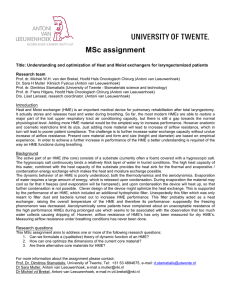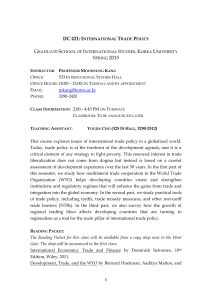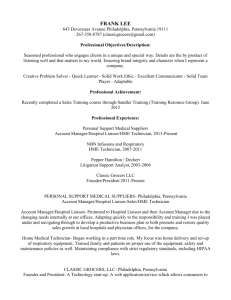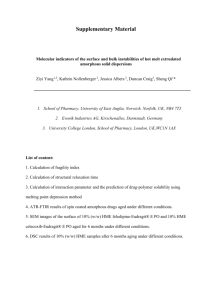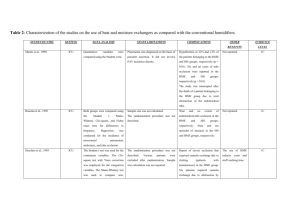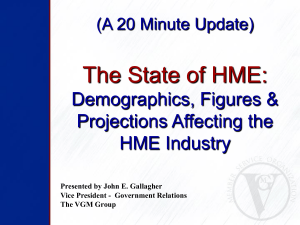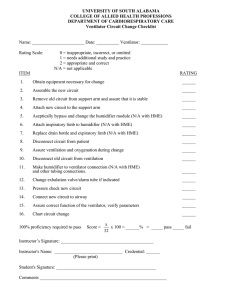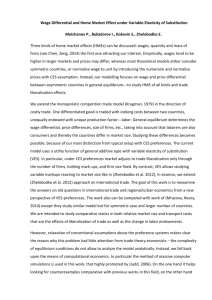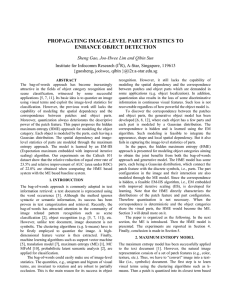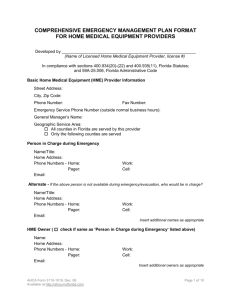Document 13727066
advertisement
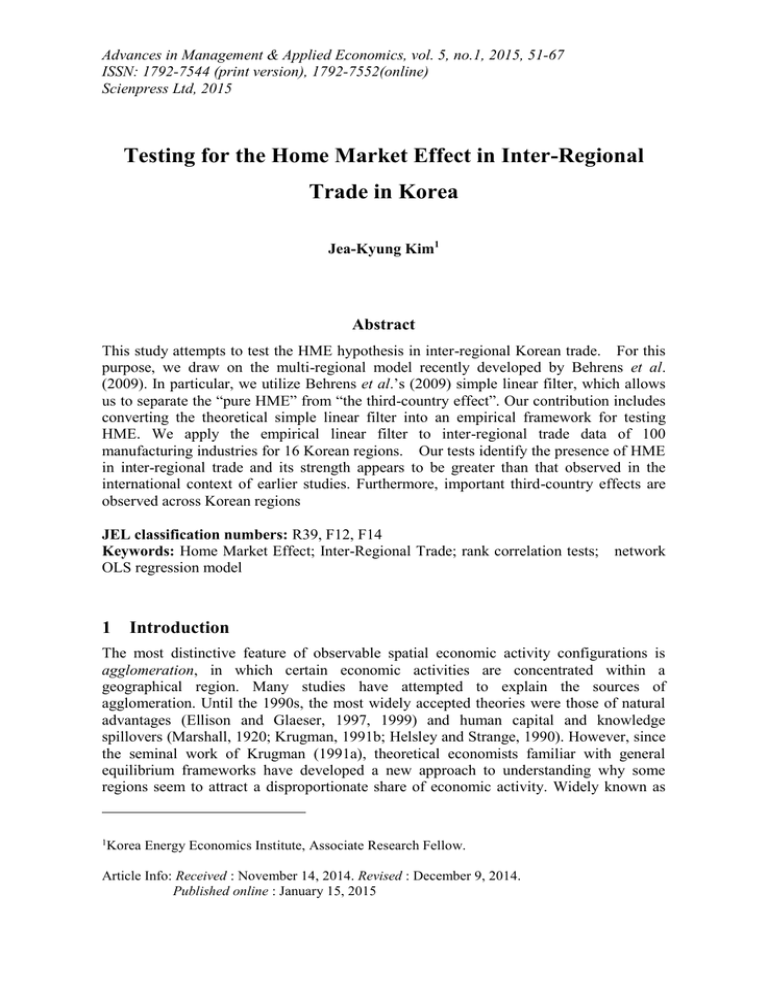
Advances in Management & Applied Economics, vol. 5, no.1, 2015, 51-67 ISSN: 1792-7544 (print version), 1792-7552(online) Scienpress Ltd, 2015 Testing for the Home Market Effect in Inter-Regional Trade in Korea Jea-Kyung Kim1 Abstract This study attempts to test the HME hypothesis in inter-regional Korean trade. For this purpose, we draw on the multi-regional model recently developed by Behrens et al. (2009). In particular, we utilize Behrens et al.’s (2009) simple linear filter, which allows us to separate the “pure HME” from “the third-country effect”. Our contribution includes converting the theoretical simple linear filter into an empirical framework for testing HME. We apply the empirical linear filter to inter-regional trade data of 100 manufacturing industries for 16 Korean regions. Our tests identify the presence of HME in inter-regional trade and its strength appears to be greater than that observed in the international context of earlier studies. Furthermore, important third-country effects are observed across Korean regions JEL classification numbers: R39, F12, F14 Keywords: Home Market Effect; Inter-Regional Trade; rank correlation tests; network OLS regression model 1 Introduction The most distinctive feature of observable spatial economic activity configurations is agglomeration, in which certain economic activities are concentrated within a geographical region. Many studies have attempted to explain the sources of agglomeration. Until the 1990s, the most widely accepted theories were those of natural advantages (Ellison and Glaeser, 1997, 1999) and human capital and knowledge spillovers (Marshall, 1920; Krugman, 1991b; Helsley and Strange, 1990). However, since the seminal work of Krugman (1991a), theoretical economists familiar with general equilibrium frameworks have developed a new approach to understanding why some regions seem to attract a disproportionate share of economic activity. Widely known as 1 Korea Energy Economics Institute, Associate Research Fellow. Article Info: Received : November 14, 2014. Revised : December 9, 2014. Published online : January 15, 2015 52 Jea-Kyung Kim New Economic Geography (NEG), this approach emphasizes the interaction between trade costs (including transportation costs) and firm-level scale economies as a source of agglomeration. More specifically, NEG outlines the forces pulling firms towards or pushing them away from a core. Examples of pulling (i.e., agglomeration) forces include lower transportation costs and a larger market size, which are conducive to firm-level scale economies. Pushing or dispersion forces include high transport costs, factor prices, and congestion. The relative strength of agglomeration versus dispersion forces partly explains why some regions attract a disproportionate share of economic activity. In contrast to conventional location theories, the NEG focus on the relation between agglomeration and trade costs overlaps significantly with the New Trade Theory (NTT). Key overlaps arise in the case of the home market effect (HME). The HME states that, in equilibrium, the economic region with the larger demand for a good shall produce a more than proportionate share of that good, ceteris paribus. That is, the production of a good will tend to concentrate in the region with the higher demand for that good. Hence, the HME can be interpreted as agglomeration in the context of NEG, as described by Krugman (1991). Since the introduction of the HME hypothesis (Krugman, 1980; Helpman and Krugman, 1985), there have been several attempts to test it empirically. Examples include Davis and Weinstein (1996, 1999, 2003), Head and Ries (2001), Trionfetti (2001), Brülhart and Trionfetti (2002), and Crozet and Trionfetti (2008). Many of these studies confirm the presence of the HME using international trade data, especially in a two-country framework. However, there have been few tests for the HME in inter-regional trade within an economy. The objective of this study is to test the HME hypothesis in inter-regional Korean trade. For this purpose, we draw on the multi-regional model developed recently by Behrens et al. (2009). In particular, we utilize their simple linear filter, which allows us to separate the “pure HME” from “positional advantages”, as the third-country effect. Our contribution includes converting the theoretical simple linear filter into an empirical framework we can use to test for the HME. we apply the empirical linear filter to inter-regional trade data of 100 manufacturing industries across 16 Korean regions. The remainder of this paper is organized as follows. In the following section, we review previous studies relevant to empirically testing the HME. Section 3 introduces the simple linear filter developed by Behrens et al. (2009) and describes how to modify the filter for empirical application. Our empirical testing is detailed in Section 4. The final section summarizes and concludes the paper. 2 Literature Review The HME is generally defined as “a more than proportional relationship between a country’s share of world production of a good and its share of world demand for the same good”(Crozet and Trionfetti, 2008). Since the HME hypothesis was initially proposed by Krugman (1980), and later modified by Helpman and Krugman (1985), as an integral part of an alternative theory of trade, NTT literature has considered the HME to be one of determinants of patterns of trade, particularly intra-industry trade, between countries. On the other hand, in the wake of the seminal work of Krugman (1991), NEG literature has utilized the HME in a different way, even though NEG is partly based on the NTT and shares several common concepts, including the HME. In the context of NEG, the HME Testing for the Home Market Effect in Inter-Regional Trade in Korea 53 states that, in equilibrium, the scale-free spatial unit (including countries and regions within a country) with the larger demand for a good shall produce a more than proportionate share of that good, ceteris paribus. That is, the production of a good will tend to concentrate in the region with the higher demand for that good. Hence, the HME can also be interpreted as agglomeration in the context of NEG. Despite both research fields’ common theoretical use of the HME, only NTT theorists have made an effort to test the HME hypothesis empirically. Among these, the most salient work is that of Davis and Weinstein (1996), which has since been regarded as the archetype of HME empirical research. In both their original study and in their follow-up work, Davis and Weinstein (1996) introduced a specification for an HME test. The test is a kind of linear approximation of the theoretical model proposed by Krugman (1980), particularly with an underlying two-country framework. In this specification, they formulated a so-called “IDIODEM” index, which is a heuristic measure of the “idiosyncratic” demand for a producer in a certain country, inclusive of the demand within the country and those around it. They conjectured that this IDIODEM index provides evidence of the presence of the HME. More specifically, the HME exists if the estimated ratio of the output elasticity to the IDIODEM index is greater than one. Indeed, it is fair to say that, notwithstanding various modifications and improvements, most of the empirical work on the HME emerged after the specification by Davis and Weinstein (1996) for a two-country framework. For example, the study of Head et al. (2001) closely followed that of Davis and Weinstein (1996), except they utilized the variables as shared notations instead of in absolute terms, based mainly on the work of Krugman and Helpman (1985). Trionfetti (2001) and Brülhart et al. (2002) attempted to decompose the HME into a magnification effect and home-biased effect, following the specifications of Head et al. (2001) and Davis and Weinstein (1996), respectively. Then, Crozet et al. (2008) extended the specification of Davis and Weinstein (1996) by introducing a product differentiation model, based on Armington (1969), including the outside good sector with an iceberg-type trade cost. This led to a simple linear relation between production and demand able to encompass more general features, such as the non-linearity of the relation. Admittedly, it is undeniable that all such works based on that of Davis and Weinstein (1996) have made notable contributions to verifying the HME hypothesis and to providing a variety of implications in regard to the HME, mostly within the context of the NTT. However, particularly in the sight of NEG empirists, these studies do have limitations as follows: First, their theoretical basis reflects a simple two-country world, which is not robust in the context of empirical research that needs to deal with a real multi-country world (or a country with many regions). Head and Mayer (2003) and Behrens et al. (2009) both noted that trade and agglomeration can take place in the interactive processes among more than two spatial units in the real world. Therefore, without considering a third unit, or more, evidence of the presence of the HME may be biased. Considering this limitation, Behrens et al. (2009) proposed a theoretical framework in a multi-country setting, extended the work of Krugman and Helpman (1985). This will be explained further in the next section. Second, their applications are restricted to a national spatial scale, even though their theoretical predictions could be applied to any spatial scale by including a scale-free parameter for trade costs(τ). In contrast to NTT research, this issue is arguably more critical within an NEG context, which has to deal with data at various and heterogeneous spatial scales. For instance, Monroe et al. (2003) listed two attributes of inter-regional trade within a country that distinguish it from international trade: higher trade freeness 54 Jea-Kyung Kim and more homogeneous spatial units. Firstly, in comparison with international trade, inter-regional trade generally has few or no frictions, such as physical distances, cultural/institutional differences, uncertainty over currency exchange rates, and explicit trade barriers such as tariffs or custom duties. In addition, inter-regional trade usually takes place between or among more homogeneous spatial units with less variation in technology or resource endowments. Applying predictions within empirical research to spatial units at a regional level must consider these differences. In this study, we test the HME hypothesis empirically while considering the aforementioned limitations. In particular, we focus on inter-regional trade within Korea, basing our study on the multi-country setting of Behrens et al. (2009), which we believe might be superior to previous studies based on a simple two-country setting. 3 Methodology 3.1 Multi-regional HME Test In this section, we first describe the multi-regional model for the HME test recently developed by Behrens et al. (2009) to introduce a simple linear filter. This allows us to separate the “pure HME” from “the third-country effect”. Indeed, the model of Behrens et al. (2009) includes the following underlying assumptions, also typical of NEG theoretical models. A national economy consists of M regions, indexed as i = 1, 2,…, M. Region i hosts an exogenously given mass of Li (>0) consumers, each of whom supplies one unit of labor inelastically, which is the only factor of production. With zi units of labor producing one unit of goods, a homogenous conventional sector good (A) is produced under constant returns. In the manufacturing sector, all varieties are produced with the same cost function, as follows: 𝑙𝜔 = 𝛼 + 𝛽𝑥𝜔 (1) The production of any variety of the differentiated good takes place under increasing returns to scale by a set of monopolistically competitive firms.2 In what follows, we denote the mass of firms located in country i as ni. Following the typical assumptions of NEG/NTT literature, the preferences of a representative consumer in region i are defined using a two-tier utility function. The upper tier of the utility function is defined over a homogenous conventional sector good (A) and over a continuum of varieties of a horizontally differentiated good (C) in a manufacturing sector, as follows: 1−𝜇 𝜇 𝐶𝑖 𝑈𝑖 = 𝐴𝑖 2 (2) This set is endogenously determined in equilibrium by free entry and exit. This condition is one of the assumptions that differs between NTT and NEG, and supposes that the size of operating firms in a region is not determined by free entry and exit but by relocation processes of firms across regions. Recently, both conditions were incorporated in the NEG framework by Okubo et al. (2010). Testing for the Home Market Effect in Inter-Regional Trade in Korea 55 Ci in equation (2) is a CES lower tier utility defined over the varieties of the horizontally differentiated good as follows: 𝐶𝑖 = (∑𝑗 (∫𝜔∈𝛺 𝑐𝑗𝑖 𝑗 𝜎−1 (𝜔) ⁄𝜎 𝜎 𝜎−1 𝑑𝜔)) (3) where cji(ω) is the consumption in country i of variety ω produced in country j, and Ωj is the set of varieties produced in country j with j=1, 2, …, M. The parameter σ >1 measures both the constant own price elasticity of demand for any variety and the elasticity of substitution between any two varieties. Next, we suppose two regions with sizes of Li and Lj, sharing the same preferences and technologies, and being open to trade. Trade is perfectly free for homogenous conventional sector goods, but there are trade costs (of the iceberg type) for manufacturing goods. In other words, to sell one unit of the good to consumers in another region, the firm has to produce τij > 1 units, because τij – 1 units are lost during transportation. Given these assumptions, and adding the firms’ profit maximization condition under the free entry and exit condition, assuming an interior equilibrium, Behrens et al. (2009) showed that the cross-region distribution of firms in equilibrium is given by 𝜇 𝑛∗ = 𝜎𝑟 𝛷−1 𝑑𝑖𝑎𝑔(𝛷−1 1)−1 (4) ∗ )𝑇 where 𝑛∗ (= (𝑛1∗ , 𝑛2∗ , ⋯ , 𝑛𝑀 ) is an interior spatial equilibrium vector of firm distribution across regions, 𝑟 (≡ 𝛼⁄𝛽 ) measures the intensity of increasing returns to scale, which is assumed to e the same across regions, and 𝛯 (≡ 𝑑𝑖𝑎𝑔(1/𝑧1 , ⋯ , 1/𝑧𝑀 )) is the diagonal matrix of absolute productivity (i.e., the nominal wage in equilibrium) in the homogeneous conventional sector. In addition, the matrix of bilateral trade freeness, Φ, in equation (4) is defined as 𝛷=( 𝜙11 𝜙21 𝜙12 𝜙22 ⋮ 𝜙𝑀1 𝜙𝑀2 ⋯ ⋱ ⋯ 𝜙1𝑀 𝜙2𝑀 ) ⋮ 𝜙𝑀𝑀 where 𝜙𝑖𝑗 (≡ 𝜏𝑖𝑗 1−𝜎 ) is a measure of trade freeness, taking the value one when trade is free and zero when trade is prohibitively costly.3 Then, let the cross-region distribution of firms in terms of the mass of firms in equation (4) be transformed to one in share notation, given by 𝜆∗ = (𝑑𝑖𝑎𝑔(𝛷−1 𝟏)𝛷)−1 𝜃 (5) 3 Behrens et al. (2009) imposed the condition that trade was free within a region, 𝜙𝑖𝑖 ≡ 1, and that trade flows between any given pair of regions were subject to the same frictions in both directions (𝜙𝑖𝑗 ≡ 𝜙𝑗𝑖 ). Since they intentionally adopted these assumptions on the freeness of trade to simplify their analysis, it does not seem that these conditions are strictly necessary in an empirical approach. 56 Jea-Kyung Kim In equation (5), θ and 𝜆∗ respectively denote the vector of the regions’ shares of total national demand (as measured by aggregate expenditure) and the vector of the regions’ shares of total national production (as measured by either aggregate fixed cost payments or, equivalently, free entry, aggregate operating profits) in the differentiated good sector. The equilibrium condition (5) reveals that the relation between 𝜆∗ and θ is linear at any interior solution and is parameterized by the trade freeness matrix, Φ. By developing such a linear relation, Behrens et al. (2009) formulated a simple linear filter to distill the pure effect of market sizes on firms’ spatial distribution (i.e., the “pure HME”) from other effects (such as the “third-country effect”) that blended within the “observable HME.” The linear filter is based on the linear decomposition of λ∗ in equation (5), represented by 𝜆∗ = (𝜂𝑊)𝜆𝑆𝐴 + (1 − 𝜂)𝜆𝐶𝐶 (6) Where W ≡ (diag(Φ−1 1)ΦΓ σ )−1 and η ≡ (1 − ϕ)⁄((1 + (M − 1)ϕ) ∈ (0,1) where ϕ is the mean value of ϕij . Equation (6) also shows that the vector of regions′ shares of total national production (λ∗ ) is the linear combination of 𝜆𝑆𝐴 ≡ 1+(𝑀−1)𝜙 1−𝜙 𝜃− 𝜙 4 1−𝜙 and 𝜆𝐶𝐶 ≡ 1⁄𝑀 𝑊𝟏5 Inverting this equation gives 𝜆𝑆𝐴 = (𝜂𝑊)−1 (𝜆∗ − (1 − 𝜂)𝜆𝐶𝐶 ) (7) Equation (7) is the simple linear filter proposed by Behrens et al. (2009), who provided the following general prediction based on the model: a more than proportional relationship between a region’s share of total national demand and its share of total production only occurs after the influence of centrality (i.e., the “third-country effect”) is filtered out through equation (7). Using this simple linear filter, we test for a “pure HME” in inter-regional trade data of manufacturing industries across Korean regions. To do so, we first convert the theoretical simple linear filter into an empirical framework. 3.2 Empirical Framework for Testing for the HME Strictly speaking, NTT/NEG general equilibrium models such as that of Behrens et al. (2009) are merely sets of mathematical tools for performing thought experiments. In addition, these tools tend to be based on somewhat unrealistic assumptions, just for the sake of mathematical convenience. When evaluating empirically testable hypotheses 4 𝑆𝐴 𝜆 is the production shares that would prevail without centrality advantage (ϕij =𝜙 for all i≠j). In this case, size and absolute advantage alone determine the cross-region variation of production shares. 5 𝐶𝐶 𝜆 is the production shares after removing the absolute advantage (zi=z for all i′s) so that θi=1/M for all i=1,…,M. In this case centrality alone determine the cross-region variation of production shares. Testing for the Home Market Effect in Inter-Regional Trade in Korea 57 derived from these theoretical frameworks, we need to relax these unrealistic assumptions and substitute them with more manipulable devices. Hence, here we describe how we applied a theoretical tool such as a linear filter to actual data prior to testing for the HME 3.2.1 Data sources The NTT considers the HME in relation to patterns of trade, while NEG perceives the HME as an implicit alternative way of indicating agglomeration, particularly in interacting with trade (or more specifically, trade cost). As a result, most HME hypothesis tests have utilized trade data. Using international trade data is especially prevalent among these studies since the vast majority of them share the same theoretical basis of NTT. However, few studies have tested the HME between regions within a country, which potentially would have interested NEG researchers or regional economists. One reason for this is that intra-regional trade data tend to be less available than international trade data. Collecting raw data and generating statistical data on international trade is easier than doing the same for inter-regional trade within a country. This is because the former, which has to go through the customs of the country, tends to be more controllable than the latter, which can happen rather more sporadically and ubiquitously within the borders of the country. Fortunately, the Korean central bank (i.e., the Bank of Korea) has published “regional input-output tables” twice (in 2005 and 2008)6 following the policy schemes for national development called the strategy for a balanced development of the nation. These regional input-output tables contain information on the volumes of trade flows among spatial units. The spatial units comprised five integrated economic regions in 2005 and 16 regions (seven metropolitan cities and nine provinces) in 2008. The tables also contain information on production (value-added and total revenues) and expenditure by spatial unit. The data are all expressed in terms of the value at producers’ prices (or mill prices), which are common to 168 sectors (including the 100 manufacturing sectors). In our actual tests for the HME, we only include the data from the regional input-output table published in 2008 (representing economy in 2005), since it provides richer information covering more regions. 3.2.2 Parameter estimation issues Since the linear filter is parameterized from a theoretical model, as shown in equation (7), I need to specify the value of the parameters constructing it. The main set of parameters, in matrix form, is merely the matrices of trade freeness (Φ), which make up matrix W in equation (5). In order to estimate the second set of main parameters, namely the trade freeness matrix (Φ), we use the method proposed by Head and Mayer (2003, 2004): ̂𝑖𝑗 𝜙 𝑚𝑖𝑗 𝑚𝑗𝑖 =√ ̂𝑖𝑖 𝑚𝑖𝑖 𝑚𝑗𝑗 𝜙 6 Tables were published in 2005 and 2008. The table published in 2005 represented the economic situation in 2003, while the table published in 2008 reflected the situation in 2005. 58 Jea-Kyung Kim where mij (= ni cij (pi τij ) = ni cij pij ) represents the value of imports from region i into region j, at a purchase price inclusive of transportation costs, and mii and mjj denote the value of commodities produced and consumed7 within region i or region j, respectively. ̂ii Following Head and Mayer(2003, 2004), we assume trade freeness within a region ( ϕ ̂ ̂ ̂ ̂ or ϕjj ) takes a unit value over all regions (i.e., ϕii = ϕjj = ϕ = 1). By applying this assumption to the data obtained from the regional input-output table, we calculate the ̂ for the 100 manufacturing sectors. Table 1 shows the geometric mean of ϕ ̂ for values ϕ every pair of regions, by sector. The mean values of inter-regional trade freeness for the Korean manufacturing sectors fall within the relatively wide range of 0.59 to 1, but are very skewed toward 1. As seen in Fig. 1, 87% of the sectors are more than 0.9. These results imply that inter-regional trade takes place very freely, particularly in comparison with international trade.8 This would seem to be quite reasonable, and is consistent with the finding of Monroe et al. (2003) on the representative attributes of inter-regional trade within a country, as mentioned earlier. Table 1: Estimated geometric mean values of ϕij by upper tier sector Sectors (No.) ̂ij ) geometric mean values(ϕ Mean S.D. Min Max Food, beverages & tobacco products 16 0.934 0.065 0.765 0.996 Textile & apparel 11 0.942 0.049 0.848 1.000 Wood & paper products 5 0.868 0.160 0.582 0.950 Printing & Reproduction of recorded media 1 0.985 0.985 0.985 Petroleum & coal products 4 0.896 0.092 0.772 0.982 Chemicals, drugs & medicines 14 0.951 0.033 0.898 0.986 Non-metallic mineral products 6 0.933 0.051 0.833 0.967 Basic metal products 8 0.945 0.033 0.898 0.976 Fabricated metal products* 4 0.989 0.004 0.984 0.995 General machinery & equipment 8 0.976 0.007 0.964 0.985 Electronic & electrical equipment 10 0.969 0.026 0.911 0.992 Precision instruments 3 0.964 0.006 0.958 0.970 Transportation equipment 7 0.939 0.097 0.720 0.988 Furniture & other manufactured products 3 0.959 0.003 0.956 0.962 100 0.945 0.062 0.582 1.000 Total * Machinery and furniture were excluded from Fabricated metal products Head and Mayer (2003) named these “imports from self” (or, equivalently, “exports to self”). For example, Head and Mayer (2003) reported estimates of trade freeness between the U.S. and Canada and between France and Germany in two sectors (textiles, apparel, and leather and motor vehicles and parts). For textiles, apparel, and leather, the U.S.–Canada trade freeness is 0.111, while the value for Germany–France is 0.130. In the case of motor vehicles and parts, the U.S.– Canada trade freeness is 0.717 and that of Germany–France is 0.114. The estimates of Head and Mayer (2003) reflecting international trade are significantly lower than our results. 7 8 59 0 5 10 Density 15 20 25 Testing for the Home Market Effect in Inter-Regional Trade in Korea .6 .7 .8 .9 1 Geometric mean of Phi Figure 1: Distribution of 𝜙̂ over sectors 4 Testing for the HME 4.1 Operational Definition of the HME Empirically testing the HME requires a testable operational definition of the HME. The HME can be defined as the disproportionate positive causation from demand to supply (Head et al., 2002). Indeed, this has already become the standard definition of the HME in both theory and applications since the HME was introduced in NTT and NEG literature, which emphasized the importance of market size in explaining the pattern of trade and industry location, respectively. However, as pointed out by Behrens et al. (2005, 2009), such a definition is “neatly implied” by a two-country (or region) framework, but it cannot be symmetrically and easily extended to a multi-country (or region) context. Hence, particularly in a multi-country (or region) world, the definition of the HME was a source of debate among researchers prior to the proposal by Behrens et al. (2005, 2009), which reads as follows. To start with, we assume that regions i and j host a sector production share that is proportional to their expenditure (or demand) share, which can be expressed as follows: 𝜆∗𝑖 = 𝑘𝑖 𝜃𝑖 , 𝜆𝑗∗ = 𝑘𝑗 𝜃𝑗 where 𝑘𝑖 and 𝑘𝑗 are positive coefficients. Since the disproportionate positive causation 60 Jea-Kyung Kim from demand to supply requires 𝑘𝑖 ≥ 𝑘𝑗 (i.e., 𝜆∗𝑖 /𝜃𝑖 ≥ 𝜆𝑗∗ /𝜃𝑗 ) whenever 𝜃𝑖 ≥ 𝜃𝑗 , in the presence of the HME, the following condition holds: 𝜆∗𝑖 𝜃𝑖 ⇒ 𝜃𝑖 ≥ 𝜃𝑗 𝜆∗𝑗 ≥𝜃 , 𝑗 ∀ j =1,2,…, M (8) Consequently, we can assert that the HME exists in region i for a certain manufacturing sector when the condition in equation (8) holds for that region towards all regions (∀ j =1, 2, …, M). In addition, on the condition that the HME exists in all regions for a sector, we can also argue the presence of the HME in that sector. Therefore, specifically assuming that region labels are ordered such that 𝜃1 ≥ 𝜃2 ≥ ⋯ ≥ 𝜃𝑀 , we can, without loss of generality, state that the HME exists in a sector when 𝜆∗1 𝜃1 ≥ 𝜆∗2 𝜃2 ≥⋯≥ 𝜆∗𝑀 𝜃𝑀 (9) which implies that the ordering in terms of production shares reflects the “natural” ordering in terms of the market size of each region. Though the two variables λ∗ θ and θ have to be discrete in the real world, if we assume that they can be defined on a continuous space of positive real numbers, we can transform this expression into the following continuous version: ∗ 𝑑(𝜆 ⁄𝜃) 𝑑𝜃 =𝜐≥0 (10) If this condition holds for the given continuous domain of θ, the presence of the HME can be confirmed. Considering only discrete data can be available, we can approximate expression (10) as ∗ ∗ ∆( λ ⁄ ) θ ∆θ ( = ∗ λ λi ⁄ − j⁄ ) θi θj θi −θj = υij ≥ 0 (11) where, if the signs of 𝜐𝑖𝑗 𝑠 are nonnegative for all i (i = 1, 2, …, M ) and j (j = 1, 2, …, M), the presence of the HME in that sector can be verified. However, from a more practical point of view, because 𝑀 × 𝑀 nonnegative 𝜐𝑖𝑗 𝑠 are required, this verification needs a weaker condition, for instance, 𝐸(𝜐𝑖𝑗 ) ≥ 0. In other words, the mean value, 𝜐𝑖𝑗 , is not statistically significantly greater than zero. This weaker condition would seem to be feasible for testing the HME, particularly when considering statistical aspects such as measurement errors, and so on. 4.2 Method of Testing for the HME To test for the HME in the Korean manufacturing sectors using the aforementioned data, especially the inter-regional trade data, we employ two alternative testing methods. The first is the rank correlation test based on expression (9). This test evaluates the consistency or correlation between the ordering of production shares and that of regional Testing for the Home Market Effect in Inter-Regional Trade in Korea 61 market size shares after filtering out the influence of positional and comparative advantage using the simple linear filter. Here, we use two nonparametric test statistics: the Spearman rank-correlation coefficient (𝜌) and the Kendall rank-correlation coefficient (𝜏). In this test, the null hypothesis is that 𝜌 = 1 (or 𝜏 = 1), which implies that both orderings (i.e., production shares and region market sizes) match each other exactly within a certain sector. If the null hypothesis cannot be rejected by a Z-test, we can confirm the presence of the HME, at least in that sector.9,10 we carry out the tests twice, by sector. The first test uses all the data. The second test uses the data after filtering out the effects described above using the simple linear filter. The second testing method is the network OLS regression method, based on equation (11). To begin with, multiplying both sides of equation (11) by the denominator (𝜃𝑖 − 𝜃𝑗 ) yields: ∗ 𝜆 𝜆∗𝑖 ⁄𝜃 − 𝑗⁄𝜃 = 𝜐𝑖𝑗 (𝜃𝑖 − 𝜃𝑗 ) 𝑖 𝑗 (12) Both sides of this equation represent dyadic relations (or more precisely, differences of variables) between the two regions. Such dyadic relations can easily be transformed into 𝑀 × 𝑀 dimensional matrices, which are given by 𝛬≡( 𝜆∗2 ⁄𝜃2 𝜆∗𝑀 ⁄𝜃𝑀 − 𝜆1∗ ⁄𝜃1 𝛩≡( 0 𝜃2 − 𝜃1 𝜃𝑀 − 𝜃1 𝜆1∗ ⁄𝜃1 − 𝜆∗2 ⁄𝜃2 0 0 − 𝜆1∗ ⁄𝜃1 ⋮ 𝜃1 − 𝜃2 0 ⋮ 𝜃𝑀 − 𝜃2 𝜆∗𝑀 ⁄𝜃𝑀 − 𝜆∗2 ⁄𝜃2 𝜃1 − 𝜃𝑀 𝜃2 − 𝜃𝑀 ) ⋱ ⋮ ⋯ 0 𝜆1∗ ⁄𝜃1 − 𝜆∗𝑀 ⁄𝜃𝑀 𝜆∗2 ⁄𝜃2 − 𝜆∗𝑀 ⁄𝜃𝑀 ), ⋱ ⋮ ⋯ 0 ⋯ ⋯ (13) Then, adding the 𝑀 × 𝑀 dimensional matrix of white noise (E) to the matrix version of equation (12), we formulate the following regression model(is the network OLS regression model): 𝛬 = 𝜐𝛩 + 𝐸 (14) The mean value of 𝜐 is utilized to construct a t-test, using the quadratic assignment procedure, to test for the presence of the HME, particularly in expression (11) (Kranckhardt, 1987, 1988). Once again, we conduct the estimations twice, by sector, as in the rank correlation test.11 9 In order to obtain bias-corrected estimates of both rank-correlation coefficients and confidence intervals for the Z-tests, we performed bootstrapping with 2000 replications. 10 The results of the Z-test for the null hypothesis at the sector level are reported in Table 1 in the Appendix. 11 The estimation results at the sector level are reported in Table 2 in the Appendix. 62 Jea-Kyung Kim 4.3 Test Results Tables 2 and 3 summarize the results of the two rank correlation tests and the network OLS regression test, respectively. Table 2: Results of Rank Correlation Tests Spearman 𝜌 (No. of sectors accepted Secto the hypothesis: 𝜌 = 1) rs Before After (No.) filtering filtering Kendall 𝜏 (No. of sectors accepted the hypothesis: 𝜏 = 1) Before filtering After filtering 99 95 90 99 95 90 99 95 90 99 95 90 % % % % % % % % % % % % Food, beverages & tobacco products Textile & apparel Wood & paper products Printing & Reproduction of media Petroleum & coal products Chemicals, drugs & medicines Non-metallic mineral products Basic metal products Fabricated metal products* General machinery & equipment Electronic & electrical equipment Precision instruments 16 2 0 0 13 10 9 0 0 0 8 5 3 11 5 7 1 0 0 0 0 6 4 3 4 1 3 0 0 0 0 0 0 2 4 1 1 1 0 1 1 0 0 1 1 1 0 0 0 1 1 1 4 14 6 8 4 1 4 2 4 2 0 1 0 0 0 0 0 0 0 0 1 8 4 6 4 1 8 3 4 4 1 6 2 4 4 0 0 0 0 0 0 0 0 0 0 0 0 0 0 0 1 6 3 5 4 0 5 1 2 3 0 3 1 0 3 8 0 0 0 8 7 5 0 0 0 7 4 2 10 4 0 0 10 7 6 0 0 0 6 4 3 3 1 0 0 3 2 1 0 0 0 1 0 0 Transportation equipment 7 3 0 0 2 1 1 0 0 0 1 0 0 Furniture& other manufactured products 3 0 0 0 3 3 2 0 0 0 2 0 0 Total 100 32 1 0 73 58 46 0 0 0 51 27 17 * Machinery and furniture were excluded from Fabricated metal products Testing for the Home Market Effect in Inter-Regional Trade in Korea 63 Table 3: Results of Network OLS regression test t- test for the hypothesis: 𝜐 ≥ 0 (No. of Sectors passed t-test) Sectors Before filtering After filtering (No.) 90% 95% 99% 90% 95% 99% Food, beverages & tobacco products Textile & apparel Wood & paper products Printing & Reproduction of media Petroleum & coal products Chemicals, drugs & medicines Non-metallic mineral products Basic metal products Fabricated metal products* General machinery & equipment Electronic & electrical equipment Precision instruments 16 11 5 1 4 14 6 8 4 8 10 3 0 5 1 1 3 2 0 2 2 2 3 2 0 4 1 1 2 2 0 1 2 1 2 1 0 2 0 1 2 1 0 1 0 0 0 1 14 14 9 9 5 4 1 1 3 2 11 10 5 5 6 6 4 4 8 8 10 10 2 2 14 8 4 1 2 9 4 6 4 7 9 2 Transportation equipment 7 1 1 0 5 3 2 Furniture& other manufactured products 3 0 0 0 3 3 3 Total 100 24 18 8 86 81 * Machinery and furniture were excluded from Fabricated metal products 75 In the third row in Table 2, the labels “99%,” “95%,” and “90%” refer to the confidence levels (or tolerance levels) used to determine whether to accept or reject the null hypothesis. Note that the confidence levels in this row appear in reverse order to the third row of Table 3 owing to the different judgment rules in each. In Table 2, we are determining whether to accept the null hypothesis (𝐸(𝜌) = 1 or 𝐸(𝜏) = 1 ). In Table 3, we are determining whether to reject null hypothesis (𝐸(𝜐) = 0). From a conservative perspective, we hereafter use the strictest criterion (i.e., confidence level) in each test to describe the implications of our results. To begin with, through overview of the results, the test with Kendall rank-correlation coefficient (𝜏) turns arguably out to be the strictest testing technique among these three ones due to the fact that Just only 17 sectors could pass the test (in other words, accept null hypothesis) after filtering as well as no sectors before filtering, while the weakest testing technique appears to be the Network OLS regression test which 8 sectors before filtering and even 75 sectors after filtering passed. Considering such the variation in testing power across testing techniques, we synthesize three results by counting the number of overlapping ones among sectors that passed each test and, in turn, report it in Table 4 with identifying those sectors. 64 Jea-Kyung Kim Table 4: Sectors exhibiting HME Before filtering Sectors Sectors Passed 3 Passed 2 tests tests After filtering Sectors Passed 3 tests Starches & other sugars Bakery & confectionery products, noodles Alcoholic beverages Textile wearing apparels & accessories Printing & reproduction of recorded media Cosmetics, soap, & other toilet preparations Plastic products Other rubber products Glass products Metal products for construction Hand tools & wire products Other fabricated metal products Engines & turbines Other machinery & equipment of special purpose Other electrical equipment & supplies Electronic signal equipment Other electric components & accessories 0 0 17 Sectors Passed 2 tests Dairy products Seasonings Canned or cured fruits & vegetables Misc. food preparations Soft drinks & ice Prepared livestock feeds Wood Wooden products Paper products Other petroleum products Inorganic basic chemical products Fertilizers & pesticides Medicaments Concrete products Steel ingots & semi-finished products Hot rolled steel products Other primary iron and steel products Primary nonferrous metal products Metal containers Parts of general-purposed machinery & equipment Other machinery & equipment of general purpose Agricultural implements & machinery & construction machinery Motors, generators, capacitors & rectifiers Semiconductors & related devices Household electrical appliances Medical, measuring, analyzing, & controlling instruments Motor vehicle engines & parts Toys & sporting goods Misc. manufactured products 29 Table 4 shows that the simple linear filter proposed by Behrens et al. (2009), modified for our empirical test, can be highly effective in confirming the presence of the HME from Testing for the Home Market Effect in Inter-Regional Trade in Korea 65 observable data. The first two columns of Table 4 reveal no sectors passed the three tests before filtering. The other two columns show that 46 sectors passed more than two tests after filtering. This result indicates we might not be able to observe the HME in any of the 100 manufacturing sectors in Korea, at least in terms of inter-regional trade, unless we filter out the other effects, particularly considering the stark contrast before and after filtering. we argue that is empirical evidence in favor of the conjecture made by Behrens et al. (2009), stating that “the HME does not generally arise in the extended model because the countries’ equilibrium production shares λ are affected not only by their demand shares θ but also by relative centrality and comparative advantage in the differentiated good sector” (Behrens et. al., 2009, p.263). 5 Conclusion The HME, indicating a disproportionate positive causation from demand to supply, is a crucial testable prediction in accounting for the pattern of trade in NTT theories and agglomeration in NEG theories. Several empirical works have tested for the HME since it was introduced, but only from the perspective of international trade within NTT theory. In addition, these tests have only investigated a simple two-country framework. Empirical HME tests in a multi-country framework, within an economy, or in inter-regional trade have received limited attention. In this study, we tested the HME hypothesis within inter-regional trade in Korea. For this purpose, we modified the simple linear filter proposed by Behrens et al. (2009), which allowed us to separate the “pure HME” from other effects blended within the data. After converting the theoretical simple linear filter into an empirical framework for testing, we applied the empirical linear filter to inter-regional trade data for 100 manufacturing sectors in 16 Korean regions. Our tests identified the presence of the HME in inter-regional trade in almost half the manufacturing sectors, but only after filtering out the influence of centrality. we argue this is empirical evidence in favor of the conjecture made by Behrens et al. (2009). References [1] [2] [3] [4] [5] Acemoglu, D., and M. Dell, Productivity Differences between and Within Countries. American Economic Journal: Macroeconomics, 2(1),(2010) 169 - 188. Armington, P.S., A theory of demand for products distinguished by place of production, International Monetary Fund Staff Papers 16, (1969),159 - 176. Baldwin, R.E., Forslid, R., Martin, P., Ottaviano, G.I.P., and Robert-Nicoud. F., Economic Geography and Public Policy. Princeton University Press, Princeton, 2003. Behrens K., A.R. Lamorgese, G.I.P. Ottaviano and T, Tabuchi, Testing the HME in a multy-country world:a theory-based approach, mimeo, 2005. Behrens K., A.R. Lamorgese, G.I.P. Ottaviano and T, Tabuchi, Beyond the home market effect: Market size and specialization in a multi-country world, Journal of International Economics, 79, (2009), 259 - 265. 66 [6] [7] [8] [9] [10] [11] [12] [13] [14] [15] [16] [17] [18] [19] [20] [21] [22] [23] [24] [25] [26] Jea-Kyung Kim Brülhart, M., and F. Trionfetti, A Test of Trade Theories When Expenditure is Home Biased, Mimeo. University of Lausanne, 2002. Combes,P-P., Industrial Agglomeration under Cournot Competition, Annales d'Economie et de Statistique, 45, (1997), 161 - 182. Crozet, M..,Trionfetti, F., Trade costs and the Home Market Effect, Journal of International Economics 76, (2008), 309 - 321. Davis, D. and D.Weinstein, Does Economic Geography Matter for International Specialization?, NBER Working Paper 5706, (1996). Davis, D. and D. Weinstein, Economic Geography and Regional Production Structure: An Empirical Investigation, European Economic Review, 43(2), (1999), 379 - 407. Davis, D. and D.Weinstein, Market Access, Economic Geography and Comparative Advantage: An Empirical Assessment. Journal of International Economics, 59(1), (2003), 1 - 23. Ellison, G. and E. Glaeser, Geographic Concentration in U.S. Manufacturing Industries: a Dartboard Approach, Journal of Political Economy ,105(5), (1997), 889 - 927. Ellison, G. and E. Glaeser, The Geographic Concentration of Industry: Does Natural Advantage Explain Agglomeration?, American Economic Review, 89(2), (1999), 311 - 316. Feenstra, R., J. Markusen and A. Rose, Using the gravity equation to differentiate among alternative theories of trade, Canadian Journal of Economics , 34(2), (2001), 430 - 447. Fujita, M., P. Krugman and A. Venables, The Spatial Economy: Cities, Regions, and International Trade, MIT Press, Cambridge, 1999. Kendall, M. and J. Gibbons, Rank Correlation Methods, Oxford University Press, 1990. Krackhardt, D., QAP Partialling as a test of Spuriousness. Social Network, 9, (1987), 171 - 186. Krackhardt, D., Prediciton with Networks: Non parametric Multiple Regression analysis of Dyadic data, Social Network 10,(1988), 359-381. Krugman, P., Scale economies, product differentiation and the pattern of trade. American Economic Review 70, (1980), 950–959. Krugman, P., Increasing Returns and Economic Geography, Journal of Political Economy, 99(3), (1991a), 483-499. Krugman, P., Geography and Trade ,MIT Press, Cambridge, 1991b. Krugman, P. and A. Venables, Globalization and the Inequality of Nations, Quarterly Journal of Economics ,110(4), (1995), 857 - 880. Head, K., Mayer, T., Ries, J., On the pervasiveness of home market effects, Economica 69, (2002), 371 - 390. Head, K. and T. Mayer, The Empirics of Agglomeration and Trade. CEPII Working Paper 2003-15, (2003). Head, K. and T. Mayer, The empirics of agglomeration and trade, In V. Henderson and J.-F.Thisse (eds.), Handbook of Regional and Urban Economics, 4, (2004), Amsterdam: North Holland, 2609 - 2669. Head, K. and J. Ries, Increasing Returns Versus National Product Differentiation as an Explanation for the Pattern of US-Canada Trade. American Economic Review ,91(4), (2001), 858 - 876. Testing for the Home Market Effect in Inter-Regional Trade in Korea 67 [27] Helpman, E.and P. Krugman, Market Structure and Foreign Trade. MIT Press, Cambridge, MA, 1985. [28] Helsley, R. and W. Strange, Matching and Agglomeration Economies in a System of Cities. Regional Science and Urban Economics, 20(2), (1990), 189 - 212. [29] Marshall, A., Principles of Economics ,Macmillan, London, 1920. [30] McCann,P., Transport costs and new economic geography, Journal of Economic Geography, 5, (2005), 305 - 318. [31] Neary, J.P., Of hypes and hyperbolas: introducing the new economic geography. Journal of Economic Literature, 39, (2001), 536 - 561. [32] Nijkamp, P., Review of The Spatial Economy: Cities, Regions and International Trade, Economic Journal, 111(469), (2000), 122 - 202. [33] Ottaviano, G., T. Tabuchi and J-F. Thisse, Agglomeration and Trade Revisited, International Economic Review , 43(2), (2002), 409 - 436. [34] Samuelson, P., The transfer problem and transport costs: the terms of trade when impediments are absent. Economic Journal, 62, (1952), 278 - 304. [35] Trionfetti, F., Using Home-Biased Demand to Test Trade Theories, Weltwirtschaftliches Archiv, 137(3), (2001), 404 - 426. [36] Trefler, D., International factor price differences: Leontief was right!, Journal of Political Economy, 101, (1993), 961 - 987. [37] Trefler, D., The case of the missing trade and other mysteries, American Economic Review, 85, (1995), 1029 - 1046 [38] Yu, Z., Trade, market size, and industrial structure: revisiting the home–market effect. Canadian Journal of Economics, 38, (2005), 255 -272.
